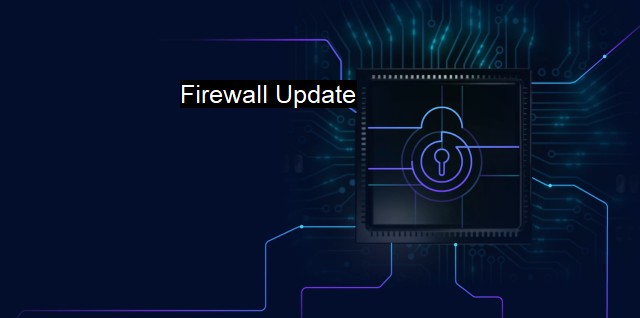What is Firewall Update?
The Role of Firewall in Cybersecurity: The Importance of Regular Updates for Optimal Protection
A "firewall update" refers to the process of adding new definitions, augmenting features, fixing bugs, and plugging security vulnerabilities within a firewall application. The term firewall in the context of cybersecurity is generally understood as a network security system that monitors and controls the incoming and outgoing network traffic based on predetermined security rules.A firewall uses configured rules to scrutinize network traffic data and prevents suspicious activities over a network. It serves as a barrier or a shield that stands between a trusted internal network and an untrusted external network, such as the internet. Firewalls can either permit or block traffic over a network depending on the security protocols set in place, safeguarding sensitive or private data.
Firewalls could be classified into two types: network-based and host-based. Network-based firewalls are typically installed on network gateways, where two or more networks meet, while host-based firewalls are installed on each network node. They could be further classified as packet filtering, stateful inspection, proxy service, application-layer, and next-generation firewalls.
With the increasing complexity and evolving nature of cyber threats, firewalls must constantly adapt and update to keep up against potential attacks. It is here that the concept of a "firewall update" becomes utterly crucial. Updates are designed to ensure the firewall can defend against the latest potential threats and maintain the highest quality of network security.
A firewall update often deals with updating definitions or the rules used for detecting potential threats. As new types of cyberthreats emerge, cybersecurity professionals create new definitions to help the system identify and deal with these threats. Updated definitions are added to the firewall security database during an update, thus enhancing its capability to recognize incoming threats and mitigate them appropriately. It’s akin to updating one's vocabulary with new words to better understand a language.
Updates polish or tweak features that enhance the functionality of the firewall, allowing them to be more accurate and precise in filtering network traffic. Addressing known software compatibility issues or other bugs that affect the performance are also key aspects of updates.
Yet, the crucial role of a firewall update is to rectify security breaches or vulnerabilities. Cyber threats are always evolving, with hackers constantly researching potential weaknesses. These vulnerabilities in the firewall system can serve as open doors for potential cyber threats if not rectified quickly. The cybersecurity community around the world collaborates and shares information about freshly discovered threats and vulnerabilities found in the existing system. When such threats are discovered, firewall developers issue updates that patch these vulnerabilities, eliminating the risk of a possible data breach or system compromise.
Failure to update the firewall could eventually lead to serious security complications, including data theft, unauthorized access, and network compromise. An updated firewall not only defends against known threats but also equips the system with advanced tools to fight against all kinds of potential threats. All these existing and emerging threats and combating capabilities are integrated into the firewall through an update.
Updates also streamline the firewall to match the system it’s protecting. For instance, if the system undergoes software updates or hardware upgrades, the firewall needs to be updated to maintain optimal functionality and integration.
a "firewall update" is a critical process undertaken regularly to ensure that the firewall remains secured against advanced threats. Updating your firewall should be considered not as an option but as part of the ongoing responsibility toward a safe and secure cyberspace. Given how rapidly cyberattacks are increasing and becoming more sophisticated, firewall updates are a key strategy to stay one step ahead of cyber criminals.

Firewall Update FAQs
What is a firewall update and why is it important in cybersecurity?
A firewall is a cybersecurity mechanism that monitors and controls incoming and outgoing network traffic. A firewall update is a software update that addresses any vulnerabilities or weaknesses in the firewall's security. It is important because cyber attackers are constantly developing new techniques to bypass firewall protection, and a firewall update ensures that your system remains protected against these new threats.How often should I update my firewall?
Firewall updates should be done regularly to ensure that your system is protected against the latest cybersecurity threats. It is recommended to update your firewall at least once a month, but more frequent updates may be necessary depending on the security needs of your organization.What are the consequences of not updating my firewall?
Not updating your firewall can leave your system vulnerable to cyber attacks. Cyber attackers are constantly developing new methods to bypass firewall protection, and outdated firewalls may not be able to stop them. This can result in data breaches, system downtime, and financial losses for your organization.Can I update my firewall manually or should I use automatic updates?
Both manual and automatic updates are available for firewalls, but automatic updates are recommended. Automatic updates ensure that your firewall is always up-to-date with the latest security patches and can provide real-time protection against new threats. Manual updates can be time-consuming and may require technical expertise, which can be a challenge for organizations with limited IT resources.| | A | | | B | | | C | | | D | | | E | | | F | | | G | | | H | | | I | | | J | | | K | | | L | | | M | |
| | N | | | O | | | P | | | Q | | | R | | | S | | | T | | | U | | | V | | | W | | | X | | | Y | | | Z | |
| | 1 | | | 2 | | | 3 | | | 4 | | | 7 | | | 8 | | |||||||